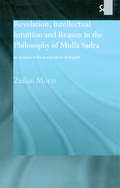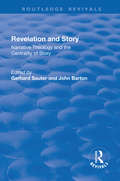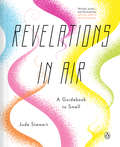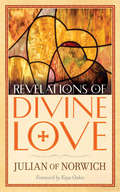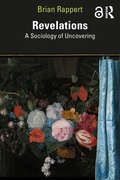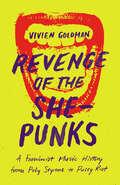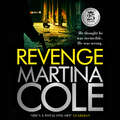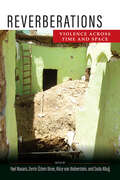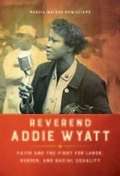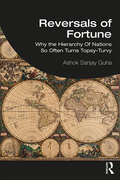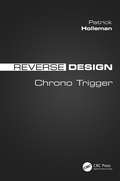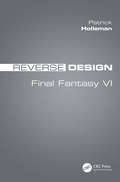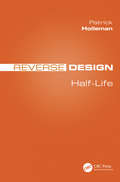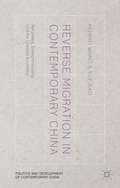- Table View
- List View
Revealing the Inner World of Traumatised Children and Young People: An Attachment-Informed Model for Assessing Emotional Needs and Treatment
by Jonathan Stanley Christine Bradley Francia Kinchington Judith Trowell Dr Alistair Cooper John Diamond John WhitwellBringing together the latest research and theory about a child's inner world and the impact of the world around them, this is a guide to understanding and responding to the emotional needs of traumatised children. Founded on the principle that traumatised children do not have a secure sense of self and therefore cannot relate to the outside world without becoming overwhelmed, this book brings psychoanalytic and psychodynamic understandings of child psychology together with current neuroscience and trauma theory. At the heart of the book is an attachment-informed assessment model and guidance for treatment. Professionals working therapeutically with traumatised children, including therapists, psychologists, psychiatrists, mental health workers, social workers and residential care workers, will benefit from the wealth of knowledge and valuable practice guidance presented in this book.
Revealing the Invisible Mine: Social Complexities of an Undeveloped Mining Project (Pacific Perspectives: Studies of the European Society for Oceanists #8)
by Emilia SkrzypekExploring the social complexities of the Frieda River Project in Papua New Guinea, this book tells the story of local stakeholder strategies on the eve of industrial development, told largely from the perspective of the Paiyamo - one of the project’s so-called ‘impact communities’. Engaging ideas of knowledge, belief and personhood, it explains how fifty years of encounters with exploration companies shaped the Paiyamo’s aspirations, made them revisit and re-examine their past, and develop new strategies to move towards a better, more prosperous future.
Revelation and Reason in Islam
by A.J. ArberryOriginally published in 1957. The "Scholastic Problem" was the focus of much debate in Islam for some centuries before it became the chief crux of learned discussion in medieval Christianity. When originally published this volume was the first survey of the subject to appear in English. It reviews the conflict within Islam between Revelation and Reason and examines the attempts made by theology, philosophy, mysticism and authoritarianism to resolve the dilemma.
Revelation, Intellectual Intuition and Reason in the Philosophy of Mulla Sadra: An Analysis of the al-hikmah al-'arshiyyah (Routledge Sufi Series)
by Zailan MorisThis book examines and analyses the legitimacy of the widely held claim that Mulla Sadra's philosophy (al-hikmah al-muta'aliyyah) is a synthesis of principles and doctrines drawn from revelation (wahy), gnosis ('irfan/ma'rifah) and discursive philosophy (al-hikmah al-bahthiyyah). In Mulla Sadra's view, these three major sources of knowledge can be brought together without contradiction and accorded their respective roles in the human quest for true and certain knowledge. This book discusses and demonstrates how Mulla Sadra achieves this synthesis as contained in and exemplified by his text, al-Hikmah al-'arshiyyah or Wisdom from the Divine Throne. An evaluation on whether or not Mulla Sadra's synthesis is successful is also undertaken. The criteria used for the evaluation are the internal coherence of his ideas, their conformity to Islamic teachings and impact on Islamic thinkers after him.
Revelations and Story: Narrative Theology and the Centrality of Story (Routledge Revivals)
by John Barton Gerhard SauterThis title was first published in 2000. From the work of Hegel and Schelling to the dialectical theology of Barth, Bultmann and Gogarten, "Revelation" has developed a long, rich tradition of diverse thought, as well as many misunderstandings. Meaning, first and foremost, "God's encounter with those to whom God wishes to communicate God's own self", Revelation seeks to be recounted and communicated to others. As a theological expression, Revelation aims to direct our attention to the modes and areas in which we have a basis for expecting encounter with God - through stories, nature, the world as creation. From a rediscovered emphasis on "story", narrative theology has emerged - a concept the English-speaking world has welcomed for its neutrality between history and imaginative fiction and stress on narrative rather than doctrinal dimension of biblical text. This volume brings into relationship a concern with theology of revelation and an interest in the theology of story or narrative theology.
Revelations in Air: A Guidebook to Smell
by Jude StewartAn extraordinary, strange, and startlingly beautiful exploration of smell, the least understood of our five senses The nose on your face is the Buckingham Palace Guard of your body, the matre d' of all taste, as well as the seducer of your imagination, and memory—and Jude Stewart has charmed them all into a wicked, poetic and illuminating tour of their mysterious domains. —Jack Hitt, author of Bunch of Amateurs Overlapping with taste yet larger in scope, smell is the sense that comes closest to pure perception. Smell can collapse space and time, unlocking memories and transporting us to worlds both new and familiar. Yet as clearly as each of us can recognize different smells--the bright tang of citrus, freshly sharpened pencils, parched earth after rain--few of us understand how and why we smell. In Revelations in Air, Jude Stewart takes us on a fascinating journey into the weird and wonderful world of smell. Beginning with lessons on the incredible biology and history of how our noses work, Stewart teaches us how to use our noses like experts. Once we're properly equipped and ready to sniff, Stewart explores a range of smells—from lavender, cut grass and hot chocolate to cannabis and old books—using smell as a lens into art, history, science, and more. With an engaging colorful design and exercises for readers to refine their own skills, Revelations in Air goes beyond science or history or chemistry--it's a doorway into the surprising, pleasurable, and unfamiliar landscape of smell.
Revelations of Divine Love
by Julian of NorwichThe fourteenth-century anchorite known as Julian of Norwich offered fervent prayers for a deeper understanding of Christ's passion. The holy woman's petitions were answered with a series of divine revelations that she called "shewings." Her mystic visions revealed Christ's sufferings with extreme intensity, but they also confirmed God's constant love for humanity and infinite capacity for forgiveness.Julian of Norwich's Revelations of Divine Love have had a lasting influence on Christian thought. Written in immediate, compelling terms, her experiences remain among the most original and accessible expressions of medieval mysticism. This edition contains both the short text, which is mainly an account of the shewings and Julian's initial analysis of their meaning, and the long text, completed some 20 years later and offering daringly speculative interpretations.
Revelations: A Sociology of Uncovering
by Brian RappertFrom tabloid headlines to scientific discoveries to investigative documentaries, the claim that truth is being revealed is commonplace today. Such attention-grabbing claims can conjure allure, sell products, launch careers, cement authority and much more besides.And yet, despite the familiarity of revelation-talk, this notion has been subject to limited academic theorizing to date outside of matters divine. Revelations sets out to examine how the making available through revealing is accomplished as well as the implications of revealing. In other words, it is concerned with how revelations are realized and what is realized through them. Central to the argument will be treating attempts to make available as processes that can entail mix – that is, as processes that combine treating truth as publicly demonstrable but also as beyond simple verification, as alternately intelligible but also as unknowable.In taking the pervasive appeal to revealing as its topic, and through drawing inspiration from a range of disciplines, this book should appeal to a variety of audiences, including those interested in secrecy, conspiracy, expertise, celebrity, science and technology.
Revenant Ecologies: Defying the Violence of Extinction and Conservation
by Audra MitchellEngaging a broad spectrum of ecological thought to articulate the ethical scale of global extinction As global rates of plant and animal extinctions mount, anxieties about the future of the earth&’s ecosystems are fueling ever more ambitious efforts at conservation, which draw on Western scientific principles to manage species and biodiversity. In Revenant Ecologies, Audra Mitchell argues that these responses not only ignore but also magnify powerful forms of structural violence like colonialism, racism, genocide, extractivism, ableism, and heteronormativity, ultimately contributing to the destruction of unique life forms and ecosystems. Critiquing the Western discourse of global extinction and biodiversity through the lens of diverse Indigenous philosophies and other marginalized knowledge systems, Revenant Ecologies promotes new ways of articulating the ethical enormity of global extinction. Mitchell offers an ambitious framework—(bio)plurality—that focuses on nurturing unique, irreplaceable worlds, relations, and ecosystems, aiming to transform global ecological–political relations, including through processes of land return and critically confronting discourses on &“human extinction.&” Highlighting the deep violence that underpins ideas of &“extinction,&” &“conservation,&” and &“biodiversity,&” Revenant Ecologies fuses political ecology, global ethics, and violence studies to offer concrete, practical alternatives. It also foregrounds the ways that multi-life-form worlds are actively defying the forms of violence that drive extinction—and that shape global efforts to manage it. Retail e-book files for this title are screen-reader friendly with images accompanied by short alt text and/or extended descriptions.
Revenge Pornography: Gender, Sexuality and Motivations
by Matthew Hall Jeff HearnFacilitated by developments in technologies, the non-consensual posting of sexually explicit images of someone else for revenge, entertainment or political motive – so-called revenge porn – has become a global phenomenon. This groundbreaking book argues that fundamental and recurring issues about how victims are violated can be understood in terms of gender and sexual dynamics and constructions, binary gender and sexual positioning and logics, and the use of sexual meanings. Using a discourse analytical approach the authors examine revenge pornography through the words of the perpetrators themselves and study the complex ways in which they invoke, and deploy, gender- and sexuality-based discourses to blame the victim. They explore strategies to curb the phenomenon of revenge porn, and by placing their research in a broader social and political context, the authors are able to examine the effectiveness of current legislative frameworks, education and awareness raising, victim support and perpetrator re-education programmes, along with wider political considerations. This enhanced understanding of the perpetrator mindset provides important insights into the use of social media to facilitate gender violence, and holds the promise of more effective interventions in future. This is a unique resource for students, academics, researchers, and professionals interested in revenge pornography and related issues.
Revenge of the She-Punks: A Feminist Music History from Poly Styrene to Pussy Riot
by Vivien GoldmanA dazzling survey of women in punk, from the genre’s inception in 1970s London to the current voices making waves around the globe.As an industry insider and pioneering post-punk musician, Vivien Goldman has an unusually well-rounded perspective on music journalism. In Revenge of the She-Punks, she probes four themes—identity, money, love, and protest—to explore what makes punk such a liberating art form for women.With her visceral style, Goldman blends interviews, history, and her personal experience as one of Britain’s first female music writers in a book that reads like a vivid documentary of a genre defined by dismantling boundaries. A discussion of the Patti Smith song “Free Money,” for example, opens with Goldman on a shopping spree with Smith. Tamar-Kali, whose name pays homage to a Hindu goddess, describes the influence of her Gullah ancestors on her music, while the late Poly Styrene's daughter reflects on why her Somali-Scots-Irish mother wrote the 1978 punk anthem “Identity,” with the refrain “Identity is the crisis you can't see.” Other strands feature artists from farther afield (including in Colombia and Indonesia) and genre-busting revolutionaries such as Grace Jones, who wasn't exclusively punk but clearly influenced the movement while absorbing its liberating audacity. From punk's Euro origins to its international reach, this is an exhilarating world tour.“In this witty, must-read introduction to punk music, Vivien Goldman sifts through decades of firsthand encounters with feminist musicians to identify how and where these colorful she-punks have arrived—and where they might be headed.”—Tin Weymouth, Talking Heads, Tom Tom Club“Revelatory . . . [Revenge of the She-Punks] feels like an exhilarating conversation with the coolest aunt you never had, as she leaps from one passion to the next.” —Rolling Stone“This book should restore Goldman’s place in the rock-crit firmament just as she sets out to give punk’s women their long-denied dues.” —The Guardian“[Revenge of the She-Punks] doesn’t just retell the story of punk with an added woman or two; it centers the relationships between gender and the genre, showing how, through the right lens, the story of punk is a story about women’s ingenuity and power.” —NPR“An engaging and politically charged exploration of women in music looking to the past, present, and future.” —Bust Magazine“Riotously entertaining . . . A vibrant and inspiring introduction to feminist music history that invites more scholarship and music making.” —Foreword Reviews
Revenge of the She-Punks: A Feminist Music History from Poly Styrene to Pussy Riot
by Vivien GoldmanA dazzling survey of women in punk, from the genre’s inception in 1970s London to the current voices making waves around the globe.As an industry insider and pioneering post-punk musician, Vivien Goldman has an unusually well-rounded perspective on music journalism. In Revenge of the She-Punks, she probes four themes—identity, money, love, and protest—to explore what makes punk such a liberating art form for women.With her visceral style, Goldman blends interviews, history, and her personal experience as one of Britain’s first female music writers in a book that reads like a vivid documentary of a genre defined by dismantling boundaries. A discussion of the Patti Smith song “Free Money,” for example, opens with Goldman on a shopping spree with Smith. Tamar-Kali, whose name pays homage to a Hindu goddess, describes the influence of her Gullah ancestors on her music, while the late Poly Styrene's daughter reflects on why her Somali-Scots-Irish mother wrote the 1978 punk anthem “Identity,” with the refrain “Identity is the crisis you can't see.” Other strands feature artists from farther afield (including in Colombia and Indonesia) and genre-busting revolutionaries such as Grace Jones, who wasn't exclusively punk but clearly influenced the movement while absorbing its liberating audacity. From punk's Euro origins to its international reach, this is an exhilarating world tour.“In this witty, must-read introduction to punk music, Vivien Goldman sifts through decades of firsthand encounters with feminist musicians to identify how and where these colorful she-punks have arrived—and where they might be headed.”—Tin Weymouth, Talking Heads, Tom Tom Club“Revelatory . . . [Revenge of the She-Punks] feels like an exhilarating conversation with the coolest aunt you never had, as she leaps from one passion to the next.” —Rolling Stone“This book should restore Goldman’s place in the rock-crit firmament just as she sets out to give punk’s women their long-denied dues.” —The Guardian“[Revenge of the She-Punks] doesn’t just retell the story of punk with an added woman or two; it centers the relationships between gender and the genre, showing how, through the right lens, the story of punk is a story about women’s ingenuity and power.” —NPR“An engaging and politically charged exploration of women in music looking to the past, present, and future.” —Bust Magazine“Riotously entertaining . . . A vibrant and inspiring introduction to feminist music history that invites more scholarship and music making.” —Foreword Reviews
Revenge of the Windigo
by James WaldramWhat is known about Aboriginal mental health and mental illness, and on what basis is this 'knowing' assumed? This question, while appearing simple, leads to a tangled web of theory, method, and data rife with conceptual problems, shaky assumptions, and inappropriate generalizations. It is also the central question of James Waldram's Revenge of the Windigo.This erudite and highly articulate work is about the knowledge of Aboriginal mental health: who generates it; how it is generated and communicated; and what has been ? and continues to be ? its implications for Aboriginal peoples. To better understand how this knowledge emerged, James Waldram undertakes an exhaustive examination of three disciplines ? anthropology, psychology, and psychiatry ? and reveals how together they have constructed a gravely distorted portrait of 'the Aboriginal.'Waldram continues this acute examination under two general themes. The first focuses on how culture as a concept has been theorized and operationalized in the study of Aboriginal mental health. The second seeks to elucidate the contribution that Aboriginal peoples have inadvertently made to theoretical and methodological developments in the three fields under discussion, primarily as subjects for research and sources of data. It is Waldram's assertion that, despite the enormous amount of research undertaken on Aboriginal peoples, researchers have mostly failed to comprehend the meaning of contemporary Aboriginality for mental health and illness, preferring instead the reflection of their own scientific lens as the only means to properly observe, measure, assess, and treat.Using interdisciplinary methods, the author critically assesses the enormous amount of information that has been generated on Aboriginal mental health, deconstructs it, and through this exercise, provides guidance for a new vein of research.
Revenge versus Legality: Wild Justice from Balzac to Clint Eastwood and Abu Ghraib (Birkbeck Law Press)
by Katherine Maynard Jarod Kearney James GuimondIn the wake of Guantanamo Bay, extraordinary renditions, and secret torture centres in Eastern Europe and elsewhere, Revenge versus Legality addresses the relationship between law and wild or vigilante justice; between the power to enforce retribution and the desire to seek revenge. Taking up a variety of narratives from the eras of Romanticism, Realism, Modernism and the Contemporary period, and including new theories to explain the interactions that occur between legalistic courtroom justice and the vigilante variety, Revenge versus Legality analyzes some of the main obstacles to justice, ranging from judicial corruption, to racism and imperialism. The book culminates in a consideration of that form of crime or lawlessness that poses the most serious threat to the rule of law: vigilante justice masquerading as legality. With its mixture of politics, literature, law, and film, this lively and accessible book offers a timely reflection on the enduring phenomenon of revenge.
Revenge: A pacy crime thriller of violence and vengeance
by Martina ColeBE SURE YOUR SINS WILL FIND YOU OUT.Michael Flynn is untouchable in a world of power, money and violence. He fights for what he wants and he takes it, whatever the cost. He learns the rules of the Life from the best and when his mentor, legendary Face Patrick Costello, is taken out, no one questions that Michael Flynn is his natural successor. For Michael, loyalty - and crime - pay.Michael Flynn rises to heights beyond anything the criminal underworld has seen. He owns everyone and he rules his empire with an even but fierce hand. No one would dare challenge him.Then the unthinkable happens. Perhaps Michael Flynn is not so untouchable after all, and he must learn that...WITHOUT THE SHEDDING OF BLOOD THERE CAN BE NO FORGIVENESS OF SINS.
Reverberations: Violence Across Time and Space (The Ethnography of Political Violence)
by Yael Navaro, Zerrin Özlem Biner, Alice von Bieberstein and Seda AltuğThe turn to the nonhuman in the humanities and social sciences has arguably been mobilized through a washing away of political violence, its histories, and its traces. Reverberations aims to redress this problem by methodologically and conceptually placing political violence and nonhuman entities side by side. The volume generates a new framework for the study of political violence and its protracted aftermath by attending, through innovative ethnographic and historical studies, to its distribution, extension, and endurance across time, space, materialities, and otherworldly dimensions, as well as its embodiment in subjectivities, discourses, and imaginations. Collectively, in the study of political violence, the contributions focus on human agencies and experiences in engagement with nonhuman entities such as objects, land, fields, houses, buildings, treasures, trees, spirits, saints, and prophets. In a variety of contexts, the scholars herein ask the crucial question: What can be learned about political violence by analyzing it in the terrain of relationality between human beings and nonhuman entities? How are things such as objects, spaces, natural phenomena, or spiritual beings entwined in histories of political violence? And vice versa—how are histories of political violence implicated in nonhuman things?
Reverence for Life: The Ethics of Albert Schweitzer for the Twenty-First Century
by Albert SchweitzerThis &“little gem of a book&” shares the Nobel laureate&’s profound insights on ethics, ecology, human rights, and more (Jane Goodall). The theologian and humanitarian Albert Schweitzer dedicated his life to the betterment of mankind. In 1952, he was awarded the Nobel Prize for his philosophy of Reverence for Life—and for the many ways he put that philosophy into action. This volume gathers together his thoughts on this profound and deeply influential concept. Based on a fundamental respect and compassion for all living things, Schweitzer&’s philosophy sought to reconcile the conflicting drives of egoism and altruism. He applied this ethical perspective to a host of topics, from war and peace to arts, animal rights, and forming a global community. Reverence for Life draws on Schweitzer&’s diverse writings across decades, including excerpts from previously unpublished letters to John F. Kennedy, Norman Cousins, Bertrand Russell, and others. A foreword by former US Ambassador, Roger Gamble, an introduction by the editor, Harold E. Robles, and a brief biographical sketch of Schweitzer&’s life round out this essential volume.
Reverence for Life: The Ethics of Albert Schweitzer for the Twenty-First Century
by Albert SchweitzerThis &“little gem of a book&” shares the Nobel laureate&’s profound insights on ethics, ecology, human rights, and more (Jane Goodall). The theologian and humanitarian Albert Schweitzer dedicated his life to the betterment of mankind. In 1952, he was awarded the Nobel Prize for his philosophy of Reverence for Life—and for the many ways he put that philosophy into action. This volume gathers together his thoughts on this profound and deeply influential concept. Based on a fundamental respect and compassion for all living things, Schweitzer&’s philosophy sought to reconcile the conflicting drives of egoism and altruism. He applied this ethical perspective to a host of topics, from war and peace to arts, animal rights, and forming a global community. Reverence for Life draws on Schweitzer&’s diverse writings across decades, including excerpts from previously unpublished letters to John F. Kennedy, Norman Cousins, Bertrand Russell, and others. A foreword by former US Ambassador, Roger Gamble, an introduction by the editor, Harold E. Robles, and a brief biographical sketch of Schweitzer&’s life round out this essential volume.
Reverend Addie Wyatt: Faith and the Fight for Labor, Gender, and Racial Equality (Women, Gender, and Sexuality in American History)
by Marcia Walker-McwilliamsLabor leader, civil rights activist, outspoken feminist, African American clergywoman--Reverend Addie Wyatt stood at the confluence of many rivers of change in twentieth century America. The first female president of a local chapter of the United Packinghouse Workers of America, Wyatt worked alongside Martin Luther King Jr. and Eleanor Roosevelt and appeared as one of Time magazine's Women of the Year in 1975. Marcia Walker-McWilliams tells the incredible story of Addie Wyatt and her times. What began for Wyatt as a journey to overcome poverty became a lifetime commitment to social justice and the collective struggle against economic, racial, and gender inequalities. Walker-McWilliams illuminates how Wyatt's own experiences with hardship and many forms of discrimination drove her work as an activist and leader. A parallel journey led her to develop an abiding spiritual faith, one that denied defeatism by refusing to accept such circumstances as immutable social forces.
Reversals of Fortune: Why the Hierarchy Of Nations So Often Turns Topsy-Turvy
by Ashok Sanjay GuhaWhy has history so often turned the economic and political hierarchy of nations topsy-turvy? This book examines the evidence of the last 500 years to challenge the two dominant narratives on the answers to this question. It argues that the explanation lies neither in the quality of institutions that societies possess nor in their capacities for technological innovation. What matters for the economic and political success of a country, it claims, is the interaction between current technological knowledge and global demand on the one hand and its geography and the population it inherits from its past on the other. Those societies succeed whose endowments best fit the requirements of current technology and world demand. It hardly matters who developed the technology. In the process of examining the patterns that inform the fates of nations over time, Reversals of Fortune charts the economic histories of Western Europe and Asia from the sixteenth century to the present day. A compelling tour de force, this book reshapes and rethinks global history. The volume will be a fascinating read for scholars of history and economics, especially economic history and human geography.
Reverse Design: Chrono Trigger
by Patrick HollemanThe Reverse Design series looks at all of the design decisions that went into classic video games. This is the second installment in the Reverse Design series, looking at Chrono Trigger. Written in a readable format, it is broken down into four sections examining some of the most important topics to the game: <li>Analyzes how the designers use gameplay to preserve and embellish the surprises in the plot <li>Explains how Chrono Trigger is really two different games: the Tragedy of the Entity and the Comedy of the Sages. <li>Highlights how the two games differ in terms of tone, linearity, player choice and in the pacing of their content. <P><P>Key Features <li>Comprehensive definitions of key concepts and terms, introducing the reader to the basic knowledge about the study of RPG design <li>Summary of historical context of Chrono Trigger how it came to be, how it influenced other games, and how it manipulated players through expectations they had about the RPG genre <li>Extensive collections of data and data visualizations explaining how Chrono Trigger’s systems work and how the game’s challenges increase in complexity as the player gets deeper into the content
Reverse Design: Final Fantasy VI
by Patrick HollemanThe Reverse Design series looks at all of the design decisions that went into classic video games. This is the first installment in the Reverse Design series, looking at Final Fantasy VI. Written in a readable format, it is broken down into six sections examining some of the most important topics to the game: <li>How narrative elements, specifically the design of the fourteen player-characters, was the critical constraint which shaped the game’s production <li>How the game broke with numerous RPG traditions in order to focus on plot and characterization, while still maintaining mechanical depth <li>How the systems were designed to allow the player to use any combination of characters with equal levels of success <P><P>Key Features <li>Comprehensive definitions of key concepts and terms, introducing the reader to the basic knowledge about the study of RPG design <li>Summary of historical context of Final Fantasy VI how it came to be, how it diverges sharply from the class-based design ideas of older RPGs, and what systems in uses to replace those old ideas <li>Extensive collections of data and data visualizations explaining how Final Fantasy VI’s systems work, how those systems evolve across the course of the game, and how the overall game systems were designed to be balanced easily
Reverse Design: Half-Life
by Patrick HollemanThe Reverse Design series looks at all of the design decisions that went into classic video games. This is the fourth installment in the Reverse Design series, looking at Half Life. Written in a readable format, it is broken down into six sections examining some of the most important topics to the game: <li>How Half-Life is a key step in the evolution from the composite style of videogame design to the set piece style of design. <li>How Half-Life defined almost all of the core concepts of the cover-based shooter, and redefined the level architecture of the FPS genre <li>The small tricks and flourishes that Half-Life used to tell a story through its mechanics, AI and environments <P><P>Key Features <li>Comprehensive definitions of key concepts and terms, introducing the reader to the basic knowledge about the study of FPS design <li>Summary of historical context of Half-Life, how it emerged from arena shooters like Doom and Quake, and how it influenced other games <li>Extensive collections of data and data visualizations explaining how systems like enemy movement, cover design and platformer physics work
Reverse Engineering of Ancient Metals
by Patricia Silvana CarrizoThis book examines archaeometallurgy and the preservation of ancient materials for cultural heritage. Through understanding the internal structures of relevant ancient materials, their chemical composition, resistance, hardness, etc., their conservation can be more effectively addressed. Preserving cultural artifacts, such as those from border sites, funerary contexts (burials), railway lines, ceremonial sites and road infrastructure, is necessary to provide perspective to a culture’s trajectory. This book addresses how Reverse Engineering can disseminate knowledge of a culture’s heritage by offering technology that can help restore artifacts so they may be displayed and utilized as educational objects.
Reverse Migration in Contemporary China: Returnees, Entrepreneurship and the Chinese Economy (Politics and Development of Contemporary China)
by Huiyao Wang Yue BaoThe authors investigate the phenomenon of highly skilled Chinese returnees and their impact on the development of the Chinese economy and society, and on the transformation of China into a key player on the global stage. They analyse the reasons why Chinese entrepreneurs choose to return to their native country and how their overseas experience shapes their attitude and behaviours. This study is solidly grounded on fresh data from online and offline surveys and on evidence collected in over 200 interviews of successful returnees entrepreneurs. These global Chinese returnees have contributed to the rise of Chinese economy into a global powerhouse and this continuing brain movement and circulation will have much more future implications and impact for China's exchange with outside world.



